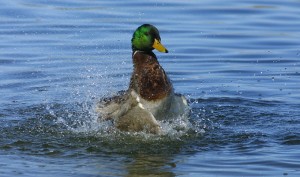As ice builds in the far northern states of the Central and Mississippi Flyways, mallard numbers have increased dramatically along the edge of the freeze line. From the freeze-line south, ducks are dispersed throughout the flyways, with the biggest concentrations along the Gulf coast. In the west, duck numbers from the Klamath Basin to the Sacramento Valley are nearing peak levels, with activity along Atlantic coast slightly below average for this time of year.
Hello folks, and, as always, welcome to Waterfowler.com.
As the Thanksgiving holiday arrived, so did the first hard freeze in many northern states. While the cold front did big freezing temperatures it did not pack the usual punch of precipitation, blizzard conditions and harsh winds that drive ducks south in mass. While migration activity did increase, the impact on mallards and geese was little more than another nudge further south – to the edge of the freeze.
Rivers and large bodies of water remain open in many areas where shallow marshes have frozen solid. Field hunting in these areas remains good to excellent in areas with heavy traffic, with hunters taking a mix of geese and various puddle ducks over dry land. For the hardcore diver hunter, it’s go time from Columbia all the way to the Great Lakes region. Goldeneye, bufflehead, bluebill and canvasback are rounding out bag limit across the north at this time.
The drought continues to impact hunter success and participation across the central part of the nation. Hunter success varies greatly across the Central Plains with the major river corridors providing the best opportunities.
Waterfowler.com reminds our readers to share the images of their hunts in our Member Photo Gallery this season, as we showcase our favorite contributions on our homepage with each update. We look forward to your participation and hunting updates as we share in the passion of the hunt this holiday season.
PACIFIC FLYWAY:
Ducks have arrived in force across northern California. From the Klamath basin to the Sacramento Valley, waterfowl numbers are good to excellent in the region, with hunters waiting on weather to move the birds around. To the north, duck numbers are good to excellent from Vancouver all the way to Montana and then south to the Great Salt Lake in Utah, where numbers have increased dramatically over previous weeks. In southern California, duck numbers are average for this time of year – with hunter success low in the absence of weather to push birds around.
CENTRAL FLYWAY:
Despite the freeze, duck numbers in South Dakota remain good to excellent at this time. Mallard and goose numbers are good to excellent into Nebraska and remain scattered southern Nebraska to the Gulf Coast. As expected, migrating birds continue moving quickly through drought stricken areas all the way to the Gulf Coast in “here today, gone tomorrow” fashion. Hunter success in Colorado has slowed as birds continue south and the other hug the eastern part of the flyway. In Texas, widgeon, pintail gadwall and green winged teal continue to fill the bulk of the bag limit with mallards low.
MISSISSIPPI FLYWAY:
As hunters in Minnesota scratched out the last limits ducks this season, goose numbers remain good to excellent in the northern third of the flyway. Mallard numbers are good to excellent as this time from Iowa to northern Illinois. Canada goose numbers remain good to excellent in Minnesota, Wisconsin and northern Illinois with snow goose numbers in Central, Illinois above average for this time of year. Widgeon, gadwall, teal and shovelers comprise the primary bag from Missouri to Arkansas, with teal and wood ducks better to the south.
ATLANTIC FLYWAY:
Bufflehead and mergansers have moved into the northern third of the flyway over the past week as other early migrators continued south. Ducks numbers are slightly below average for this time of year across the New England states as early migrants continue south and few migrants from the north have replaced them. Goose numbers are fair to good from Chesapeake Bay north, with Brant numbers fair. In the south, wood ducks, teal and ringed necked ducks continue to fill the primary slots in the bag with all other species low.
Until our next update, hunt safe and hunt often.
Member Photo Credit: hannibal






